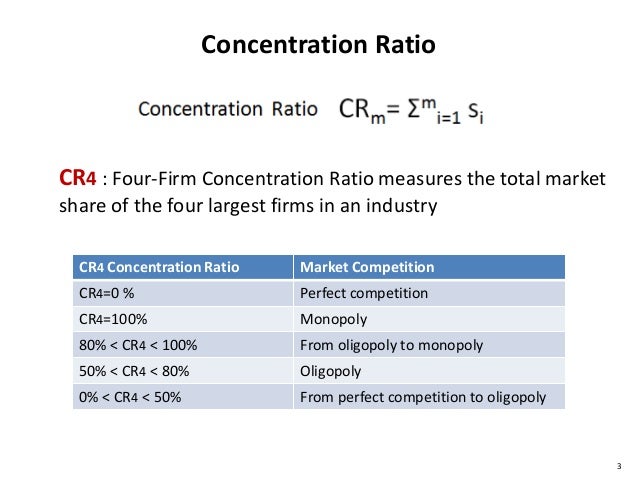Chapter 4. Competitive and concentrated markets. Revision notes
- Created by: Nathan890
- Created on: 13-04-17 18:16
Types of firms in a market
Price taker- A firm that accepts the market price, as it is out of their control. This is due to the conditions being out of their control.
Price maker- A firm that will have the power to set the market price, which all firms then follow.
Types of markets
Perfect competition- is when there is lots of different firms in a market and everyone in that market has perfect information. There is only one good or service and the market decides the price.
Competitive markets- This is where firms strive to do better than their rivals, but might not meet the conditions of perfect competition.
Concentrated markets- This is where only a few firms are in the market or in extreme cases only one.
Pure Monopoly- This is when there is only one firm in the market
Imperfect competition- any market structure lying between the extremes of perfect competition and apure monopoly.
Objectives of firms
Profit maximisation- this is when a firm is making the highest possible profit that it can. Revenue is massively above total costs.
Sales maximisation- occurs when sales revenue is maximised.
Other possible objectives:
-
Growth maximisation occurs when the decision makers within a firm try to make the firm grow as fast as possible, even though this could damage any profits.
-
Market sharemaximisation, this is when a firm tries to increase their market share within a market.
-
Firms may want to just survive, if the market is really competitive.
Barriers
Entry barrier- makes it difficult or impossible for new firms to enter a market.
Exit barrier- Makes it difficult for firms to leave markets
Natural barriers- This isn’t a man made barrier to market entry. Things like economies of scale and indivisibilities.
Artificial barriers- These are man made to stop people entering a market. E.G. Patents
Monopolies and monopoly power
-
The strict definition of the word monopoly is a pure monopoly. Where there is only a firm in a market.
-
The looser definition is to do with a market where there is one firm controlling it, but there is other small firms.
-
Natural monopoly- This will happen if there can only be one firm that can benefit fully from the us of economies of scale.
-
When a firm or country has complete control over natural resources.
-
And
-
When a market can only have one firm benefiting from economies of scale.
Patent- This is a barrier that is strategic or manmade, in order to protect a firm who is a sole producer of a good or service. This is made by the gov and is a legislation
-
Advertising and monopoly power
Informative advertising: This provides consumers and producers with useful info about a good or service. As it provides useful info, it usually creates more competition.
Persuasive advertising: This attempts to convince customers to buy the good or service, and it is good for them. This can reduce competition, because customers are unwilling to buy a cheaper substitute.
Saturation advertising- This is covering the market with info and persuasion about a firm’s product. This can be a man made barrier to entry.
Product differentiation- This is the making of a product different to other products in the market. This can be through, product design, the method of producing it, or its functionality.
Q setter
The two ways the downward curve affects the monopolist are:
-
It dictates the maximum output that can be sold at this price.
-
But, if they are a quantity setter, the curve dictates the maximum price at which the chosen quantity can be sold.
Quantity setter- this is how much of the good to sell in the market is dictated by one firm.
concentration ratio and market structures
Oligopoly- this is a market where there is a few firms that completely dominate it.
Resource allocation- when resources are allocated in a way which does not maximise economic welfare.

Productive inefficiency and monopoly
Collusion- is the co-operation between firms, for example to fix prices. Some forms of this can be in the public interest.
invention and innovation
Invention- creating new ideas for products or processes.
Innovation- converts the results of inventio into marketable products or services.
The competitive market process
Price competition.
-
This is where a firm will reduce the price of a good or service, to gain more sales, and make customers notice them more.
-
It is suggested competitive firms don’t do this, because it leads to price wars.
Special offer pricing- This is firms introducing a special offer on their price for a short period to increase profits.
Limiting pricing- This is where firms in a competitive market sacrifice short-run profit maximisation in order to increase long-run profit maximisation. Reducing the price of a good to just above average costs to deter the entry of new firms into the market.
Predatory pricing- temporarily reducing the price of a good to below the average cost to remove small firms,or the prevent a new firm entering the market.
Related discussions on The Student Room
- 3rd year 2nd semester »
- Market structures help »
- Business Studies A-Level Pearsons Edexcel PAPER 3 »
- Economics a level »
- Edexcel A Level Economics A Paper 1 (9ECO 01) - 18 May 2023 [Exam Chat] »
- Economics Competition Help »
- Problem solving the smc 2023 »
- A-level not sat on one go »
- BTEC Business Pearsons Unit 2 - Developing a Marketing Campaign »
- Btec level 3 Business »
Comments
No comments have yet been made